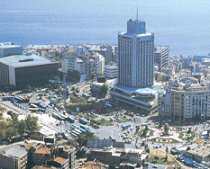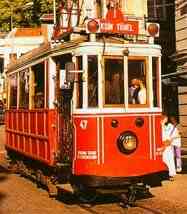
Latest News
New openings in 2025
The Zeyrek Cistern is opened to visits after years of restorations.
Entrance fees
As of 1st of March 2024, many State museums' fees are set in Euros, to be paid its equivalent in Turkish Liras.
Museum Pass
You can buy the "Museum Pass" for foreigners which is valid for 5 days in various museums of Istanbul.
Museums open 7 days
Many State museums in Istanbul operate 7 days a week, except Topkapi Palace.
Taksim Square in Istanbul
 Taksim Square is the most known modern city center of Istanbul. Many hotels and restaurants are in or near the Square and on Istiklal Street, and there is a local bus terminal for public transportation and the main subway station. Istiklal pedestrian street has many bars, night clubs and movie theaters therefore it's always busy with young people almost for 24 hours a day. The Square is also the meeting place to celebrate New Year's Eve, parades, public concerts and other shows. There is a small green park next to the square, called as Gezi Park.
Taksim Square is the most known modern city center of Istanbul. Many hotels and restaurants are in or near the Square and on Istiklal Street, and there is a local bus terminal for public transportation and the main subway station. Istiklal pedestrian street has many bars, night clubs and movie theaters therefore it's always busy with young people almost for 24 hours a day. The Square is also the meeting place to celebrate New Year's Eve, parades, public concerts and other shows. There is a small green park next to the square, called as Gezi Park.
The most important monument in Taksim Square is the Independence Monument (Istiklal Aniti in Turkish), standing at the beginning of Istiklal pedestrian street. This is also the turnaround point for the old tram which is the only vehicle permitted on Istiklal Street beside official (police and government) cars.
The monument was made by the Italian sculptor Pietro Canonica and opened in 1928, it describes Atatürk, founder of the Republic, as a military commander-in-chief and a statesman. Since it's opening, the monument became the center spot of official ceremonies in Istanbul.
On its south façade overlooking the Siraselviler Street, there is Atatürk, Ismet Inönü and Fevzi Çakmak in the front and other figures behind them, including two Russian generals. On the north façade overlooking at Cumhuriyet Street, the War of Independence is symbolized. On the east and west façades, the Turkish Army is symbolized with a soldier holding the Turkish Flag.
Across this monument on the other side of the Square, there is a huge building which is Atatürk Cultural Center. In the early years of the Republic, an opera building was started to build which was completed after a long construction period of 13 years. It was opened with the name of Istanbul Cultural Palace in 1969 but suffered a great damage because of a fire in 1970. It was renovated and was given the name of Atatürk Cultural Center in 1978, known as AKM. Several national and international concerts, operas, meetings, exhibitions and premiers are held in AKM, especially performances of Istanbul State Theaters, State Opera and Ballet, State Symphony Orchestra, State Turkish Classic Music Chorus, and International Istanbul Festival attracts thousands of spectators. It's rennovated between 2008 and 2021, then re-opened for performances.
During the late Ottoman period Sultan Mahmut I arranged Taksim as a point where the main water lines from north of Istanbul were collected and branched off to other districts of the city. Therefore the Square took its name from the big stone reservoir located on the west side of the square; "taksim" means "distribution" in Turkish.
During some of the daily city tours in Istanbul you may have a chance to pass thru this lively Square, or walk on the Istiklal Street all the way to Galata Tower.
Click here for high resolution photo gallery of Taksim.
Beyoglu and Istiklal Street
Beyoglu next to the Taksim Square is an important part of modern Istanbul, it's a great way to get away from the old city and enjoy modern Istanbul as the local people do. There is so much going on in the approximately 2,5 kilometers (1,5 mile) long street between Taksim Square and the Tünel funicular stop near Galata Tower where you can spend a whole day here. You can find a different kind of Istanbul in every corner, there is a hidden story of the city everywhere. Religions, languages and ethnic groups live brotherly around here, it's the center of art and culture, many national, international and local activities reach art lovers through the neighborhood.
 Beyoglu is mostly a residential area consisting of 45 neighborhoods and
about 226,000 residents, but the daily population goes up to a million in this center of commerce, entertainment and culture. It's one of the most important tourist points and one of the most famous avenues of the city, distinguished brands of business and entertainment world serves in this area as well. Many exquisite boutiques, music and bookstores, libraries, art galleries, cinemas, theaters, cafes, bars, restaurants, pubs, coffee houses, patisseries, chocolateries, and technological centers are lined on Istiklal Street.
Beyoglu is mostly a residential area consisting of 45 neighborhoods and
about 226,000 residents, but the daily population goes up to a million in this center of commerce, entertainment and culture. It's one of the most important tourist points and one of the most famous avenues of the city, distinguished brands of business and entertainment world serves in this area as well. Many exquisite boutiques, music and bookstores, libraries, art galleries, cinemas, theaters, cafes, bars, restaurants, pubs, coffee houses, patisseries, chocolateries, and technological centers are lined on Istiklal Street.
Beyoglu has a large number of foreigners of all nationalities living in this neighborhood. The area is also home to significant Turkish Christian and Jewish communities, there are several churches and synagogues.
The Galatasaray Square is almost at the halfway of the Avenue and houses one of the oldest educational institutions established in Turkey during the Ottoman Empire; formerly known as Mekteb-i Sultani (School of Sultans), todays Galatasaray Lisesi (high school) where the Galatasaray football team was founded in 1905.
Across Galatasaray Square there are some historic buildings such as the Cicek Pasaji (The Flower Courtyard) with many small restaurants and taverns, and Balik Pazari (Fish Market) where you can find some fresh fish and vegetables.
On the same street and on its side streets there are several churches such as St. Antony and Santa Maria, Armenian Churches, Synagogues, old mosques, Pera Palace Hotel built in 1892 by George Nagelmackers, academic and cultural institutions established by various European nations such as Germany, Italy, Austria, and France in the early 19th century, consulates of several nations including Germany, France, Greece, Sweden, Armenia, Russia, Netherlands, Spain, Sweden, and United Kingdom, amongst which the British and German consulates being the most impressive buildings in the area.
To the end of this pedestrian street towards Galata, there is Tunnel, the world's second-oldest subway, connecting Pera district with Karaköy district on the Golden Horn. Just before Tunnel you can visit Divan Literature Museum which is called as Galata Mevlevihane belonging to Mevlevi order founded by Mevlana, where Whirling Dervish ceremonies are performed twice a month.
Old Galata and Pera neighborhoods were inhabited since the Byzantine Empire. During the 19th century Ottoman Empire, the street was known as Grande Rue de Pera and the district became a center for foreigners, Levantines, Ottoman intellectuals and western culture admirers. After 1923 the street's name was changed to Istiklal (Independence in Turkish) to commemorate the War of Independence led by Atatürk.
Click here for high resolution photo gallery of Beyoglu.
Hope to see you soon in Istanbul.

